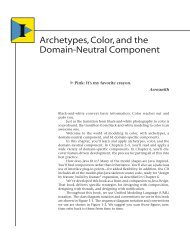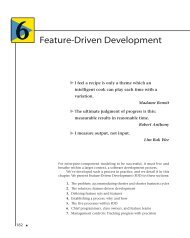Connie's Convenience Store - About Peter Coad
Connie's Convenience Store - About Peter Coad
Connie's Convenience Store - About Peter Coad
Create successful ePaper yourself
Turn your PDF publications into a flip-book with our unique Google optimized e-Paper software.
46 Connie’s <strong>Convenience</strong> <strong>Store</strong> Establishing Responsibilities for Problem-Domain Objects<br />
Cash drawer<br />
Establish responsibilities: “what I know.”<br />
What does a cash drawer object know? It knows its:<br />
– balance<br />
– position (open, closed)<br />
– operational state (okay, jammed, missing).<br />
An important note about operational state<br />
Whenever an object represents an interacting system or device, it needs to know its “operational<br />
state.” You’ll need to add service descriptions that portray state-dependent behavior<br />
(keywords: precondition, trigger, terminate, postcondition).<br />
Establish responsibilities: “who I know.”<br />
A cash drawer object knows its:<br />
– register.<br />
Establish responsibilities: “what I do.”<br />
What does a cash drawer do?<br />
– open.<br />
When you tell a cash drawer object, an abstraction, to open itself, what happens?<br />
The cash drawer object sends an electrical signal to the actual cash drawer device, activating<br />
it, so it will open.<br />
(<strong>Peter</strong>) Hey, Connie, how about a cash drawer that closes automatically?<br />
(Connie) Nice idea, especially if someone leaves their drawers open in public.<br />
(Sorry about that.) Anyway, automatically closing cash drawers are not available.<br />
Go ahead and add cash-drawer responsibilities to your model (Figure 1–30):<br />
Register<br />
1 1<br />
CashDrawer<br />
operationalState<br />
position<br />
balance<br />
Figure 1–30: Cash drawer: “what I know; who I know; what I do.”<br />
Tax category<br />
Establish responsibilities: “what I know.”<br />
A tax category object knows its category, its rate, and its effective date.<br />
Note: a combination of category and rate values might occur again and again, on<br />
various dates. This makes it a good candidate for an item-specific item pattern (although<br />
this is not pursued further in this chapter).<br />
open




